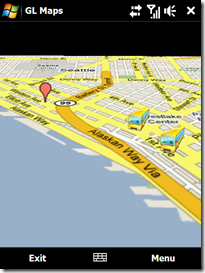Wednesday, April 19, 2017
SCR Screen Recorder Pro root Apk 0 10 2 beta Download
SCR Screen Recorder Pro root Apk 0 10 2 beta Download

Ive been spending the past few days fleshing out the GL Maps API: my goal is to allow any developer to view, modify, or add content into the map. Thats the approach Microsoft and Google have taken with their JavaScript/web clients, but neither of those run particularly well on a phone. And theyre not 3D and accelerometer savvy either! So, Im hoping that other bored engineers at XDA-Developers decide to write their own plug-ins and help make this a great application. :)
So, to foster that, Im open sourcing the "standard" plug-ins Ive written so far:
- GPS and Google Gears Geolocation Plug-In: This requires that Google Gears be installed on your phone. Download the CAB from http://dl.google.com/gears/current/gears-wince-opt.cab
- Nav Sensor Plug-in
- Seattle Metro Bus Tracker
GL Maps Download.
GL Maps SDK and source code to the standard plug-ins.
Developers wishing to make their own plug-ins can do so pretty easily.
- Create a new C# Smart Device Class Library Project (.NET CF 3.5). Name it GLMaps.PlugInName. Your assembly/project name must start with "GLMaps." so that GL Maps knows that it is a plug-in assembly.
- Add a reference to GLMapsPlugin.dll (included in the source code download).
- Create a public class and implement the following interface:
using System;
using System.ComponentModel;
using System.Windows.Forms;
namespace GLMaps
{
// Summary:
// IGLMapsPlugin defines the Plugin interface used by the GL Maps application.
public interface IGLMapsPlugin : IDisposable
{
// Summary:
// MapObjects contains a list of objects that are to be shown on the map.
BindingList<IGLMapsObject> MapObjects { get; }
//
// Summary:
// Return the Plugins MenuItem that should be added to the GL Maps application
// menu. If null, this plugin will not have a MenuItem.
MenuItem MenuItem { get; }
//
// Summary:
// Name of the IGLMapsPlugin as it is seen in the list of Plugins in GL Maps.
string Name { get; }
//
// Summary:
// TimerInterval is the interval in milliseconds at which the OnTimer interval
// is called.
int TimerInterval { get; }
// Summary:
// Initialize is the first method called by the IGLMapsPluginHost. When called,
// the plugin should do all its necessary one time setup.
//
// Parameters:
// host:
void Initialize(IGLMapsPluginHost host);
//
// Summary:
// OnTimer is called by the Plugin host every TimerInterval. If the Plugin needs
// to update data on a heartbeat, it should be done in this method. OnTimer
// is called on the UI thread, so any operations that may take a long period
// of time should take place on a separate thread so as not to hang the UI.
void OnTimer();
}
}
Simple plug-ins should only take 10~20 lines of code!
Note:
This API will change and evolve in the next few weeks as I fill any holes or add new features. Any breaking changes will require a recompilation of existing plug-ins.
Go to link for download